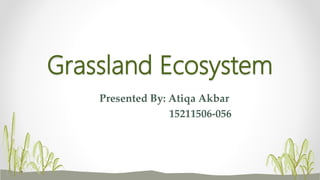
grasslandecosystem-19071315555500505.pdf
- 1. Grassland Ecosystem Presented By: Atiqa Akbar 15211506-056
- 2. Introduction • Grasslands are areas where the vegetation is dominated by grasses (Poaceae) however, sedge (Cyperaceae) and rush (Juncaceae) families can also be found along with variable proportions of legumes, like clover, and other herbs. • Grasslands occur naturally on all continents except Antarctica.
- 3. Characteristic of Grassland • Grasslands are dominated by grass with few or no trees. • They develop in areas where there is not enough rain for a forest and too much for a forset, therefore it is refered to as a transitional landscape. • Grasslands are found in both temperate and tropical areas where rainfall is between 250mm and 900mm per year. • Can be natural or a result of human activity.
- 4. • Grasslands are also one of the most endangered biomes and easily turned to desert. • In Australia they are one of the most threatened habitats.
- 5. Distribution of Grasslands Across The World • Grasslands covers 25% of the Earth's surface.1 billion people depend on their livelihood as a food source. • Grasslands are found on every continent except Antarctica. Fig 1.1: Map shows the temperate grasslands and the savaannah/tropical grasslands in the world.
- 6. Climates • Grasslands often occur in areas with annual precipitation is between 600 mm (24 in) and 1,500 mm (59 in) • Average mean annual temperatures ranges from −5 and 20 °C. • However, some grasslands occur in colder (−20 °C) and hotter (30 °C) climatic conditions. • Grassland can exist in habitats that are frequently disturbed by grazing or fire, as such disturbance prevents the encroachment of woody species.
- 7. • Species richness is particularly high in grasslands of low soil fertility such as serpentine barrens and calcareous grasslands, where woody encroachment is prevented as low nutrient levels in the soil may inhibit the growth of forest and shrub species.
- 8. Biotic Components • Producer Organisms In grassland, producers are mainly grasses; though, a few herbs and shrubs also contribute to primary production of biomass. Some of the most common species of grasses are: 1. Brachiaria sp. 2. Cynodon sp. 3. Desmodium sp. 4. Digitaria sp.
- 10. Cont. • Consumers In grassland, consumers are of three main types: 1. Primary Consumers The primary consumers are herbivores feeding directly on grasses. 2. Secondary Consumers These are carnivores that feed on primary consumers (Herbivores). 3. Tertiary Consumers These include hawks etc. which feed on secondary consumers. • Decomposers These include wide variety of saprotrophic micro-organism like: Bacteria; Fungi; Actinomycetes.
- 12. A-biotic Components • These include basic inorganic and organic compounds present in the soil and aerial environment. • The essential elements like C, H, N, O, P, S etc. are supplied by water, nitrogen, nitrates, sulphates, phosphates present in soil and atmosphere.
- 13. Types of Grassland Ecosystems • A grassland consists of large rolling fields of grasses, flowers and herbs. • There are two main types of grasslands tropical and temperate with several subcategories within each type. 1. Tropical Grasslands 2. Temperate Grasslands
- 14. Tropical Grasslands • Tropical grasslands are warm all year round with established rainy and dry seasons. • During the rainy season, tropical grasslands receive between 50 and 130 centimeters of rain. • Most notable of the tropical grasslands is the African savanna, which has an occasional tree and is home to many of the world's most spectacular species, such as elephants, giraffes, lions and zebras. • Savanna grass is usually quite short, making for excellent grazing and hunting grounds.
- 16. Temperate Grasslands • Temperate grasslands also have two seasons, growing and dormant. • During the dormant season, no grass or crops grow because it's too cold. • These grasslands make for excellent farming because of their deep and nutrient-rich soils. • Temperate grasslands receive between 25 and 75 centimeters of rain a year.
- 17. Fauna of the Grasslands • Grassland have high number of invertebrates than any other taxonomic group • Most reptiles and amphibians are predators • Few bird species inhibit grasslands • Small mammals like moles, shrews, squirrels are present in North American Grassland
- 19. Plants of the Grasslands • When rainy season arrives, many grasslands become coated with flowers, some of which can survive well into winter with the help of underground storage organs and thick stem bases. • Grasslands are the most agriculturally useful habitat to humans. • Soils tend to be deep and fertile, perfect for cropland or pastures.
- 21. Grassland of Pakistan • Located at: 1. Gilgit 2. Khashmir 3. Waziristan 4. Lower chitral 5. North kallat 6. kaghan
- 22. Cont. • Babusar pass • Minimerg • Wildlife • Deosi plateau
- 23. Threats • Continued global warming could turn current marginal grasslands into deserts as rainfall patterns change. • Development of urban areas is increasingly cutting into grassland habitat. • Drought-hardy, cold-resistant, and herbicide-tolerant varieties of soybeans, wheat, and corn allow crops to expand into native grassland. • Where only one crop is grown, pests and disease can spread easily, creating the need for potentially toxic pesticides.
- 24. Importance • Grasslands are of vital importance for raising livestock for human consumption and for milk and other dairy products • Grasslands provided home to many different animals that were hunted and domesticated • They are used as grazing area for cattle of Ruler Community • They Maintain Biodiversity • Protects restored habitat for many plants and animals including pheasant, ducks, songbirds and endangered species
- 25. How to Conserve it? • Preventing Illegal Wildlife Hunting • Prevents grassland from turning into brush land • Prevent Grassland Fires • Prevent Overgrazing by Cattles and introduced Stall feeding • Creating Protected areas such as Parks and Wildlife Sanctuaries